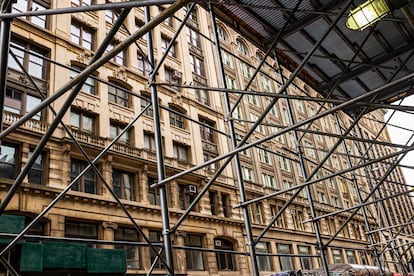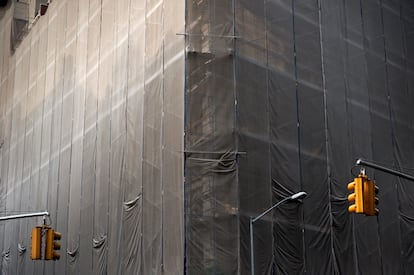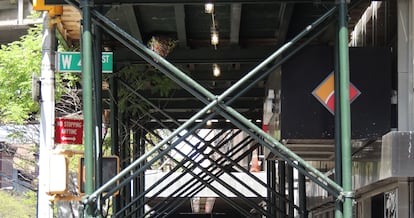Over 370 miles of construction scaffolding mar the streets of New York City
Property owners erect them to facilitate building renovations and protect pedestrians, but some have been in place for over 10 years

Like the dinosaur in the short story by the Latin American writer Augusto Monterroso, when New Yorkers woke up, the scaffolding was still there. It is hard to pinpoint how and when the nightmare started. These metal and wood structures were first erected during construction projects to protect pedestrians from accidents, such as the falling masonry that fatally injured university student Grace Gold in 1979. Scaffolding proliferated haphazardly in the 1990s and took over the city during the 2008 real estate crisis. The Covid-19 pandemic made them a permanent part of the city’s landscape. Penelope Green, a style and design expert for The New York Times, describes them as “New York’s reviled and precarious exoskeleton” – a blanket over the city that “conceals some of its most iconic façades, but protects its citizens from falling debris, wind and rain.”
Fran Henley, a 39-year-old office worker in Manhattan’s Clinton neighborhood, has lived for years in and around buildings wrapped in scaffolding. “I can see three from my window right now, and there are two others to my left on the way to the subway station,” she says with amused resignation. Strong winds blew down the scaffolding on a Broome Street building in 2018, says Henley. “There were no fatalities or injuries, but it demolished a private parking lot below.” The scaffolding was quickly replaced, and it’s still there five years later. Henleys says the scaffolding always comes back. “We live surrounded by temporary structures that become permanent, disfiguring the city and blotting out natural light for people who live and work in these buildings.” Visitors encounter a city full of eyesores that has lost some of its photogenic charm. But worst of all, it’s “a daily disaster” for those who live there.

What’s the plan?
“New York City stopped being the asphalt jungle over 10 years ago, and is now a scaffolding jungle,” said Russell Poole, editor of City Signal magazine. Using data from the city’s Department of Buildings, Poole says there are 9,046 scaffolding structures scattered around the five boroughs. Nearly 4,000 are in Manhattan, the most famous and densely populated borough known for its rich architectural heritage, Art Deco skyscrapers, Victorian mansions and Tudor-style homes. The New York City Council requires builders to erect “sidewalk sheds” – a specific type of scaffolding that covers building façades, sidewalks and pedestrian walkways to protect people from debris that could fall from construction work above.
NBC reporter Andrew Siff says the city’s new mayor, former police officer Eric Adams, has a plan to get rid of long-standing sidewalk sheds. Council member Shaun Abreu said, “The time has come for us to show that scaffolding doesn’t dominate the city.” The plan has four pillars, says Manhattan borough president Mark Levine: “Active municipal supervision of all scaffolded façades, focusing on those that have been up for over five years; low-interest loans for property owners undertaking renovation projects; speedier and more flexible work permits; and heavy fines for non-compliance.”
The implementation plan, which will use drones and other technological monitoring tools, feels like a declaration of war on a problem that has blighted the city’s image. Siff says this isn’t City Hall’s first attempt at tackling the issue. Former Mayor Michael Bloomberg (2002-2013) saw the scaffolding as an undesirable side effect of the housing crisis, and in 2009 pledged to reverse the trend with “medium term” measures. His successor, Bill de Blasio, promised in 2017 to rid the city of the scaffolding plague before he left office.
Over 370 miles of scaffolding

Time Out reporter Anna Rahmanan says that all lined up, New York City’s scaffolding would stretch over 370 miles (600 kilometers), a figure that has remained relatively stable since the end of the pandemic. There were 8,900 structures at the end of 2021 and almost 10,000 by mid-2022. NBC’s Siff says the most annoying thing about these supposedly temporary installations is their permanence. The sidewalk sheds around town have been up for an average of 498 days, and 260 were installed over five years ago. The city’s interactive map only shows the most recent renewal date of the scaffolding license, says Siff, although more digging reveals that “some have been there for 10 years or more.”
A school built over 80 years ago on West 93rd Street is an architectural landmark, but its façade was covered with scaffolding and tarps in 2014 to protect students and staff from falling construction debris. It’s still there. In 2021, neighborhood resident Gui Stampur said, “It only took a year and 45 days to build the Empire State Building. It’s unacceptable that the renovation of a roof and façade is still not finished seven years later.”
The explanation is that the building is not actually being renovated, says Siff. “Since the late 1990s, and especially after the 2008 real estate crisis, many property owners found that shoring up buildings with temporary fixes was much cheaper than restoring them. A short-term solution has become nearly permanent.” Many experts say this is an unintended impact of Local Law 11, which was enacted in 1998 and requires buildings over six stories to be inspected and repaired every five years. But the law doesn’t specify a time limit for the inspections and repairs. Theoretically, a building with scaffolding is actively being inspected or repaired. The scaffolding also enables property owners to comply with safety regulations, since it provides protection against falling debris.
Urban art on the New York exoskeleton

Víctor Alaverda, the New York correspondent for a magazine published by a Spanish association of architects (COAC), got fed up with the flagrant abuse six years ago when the city had around 7,800 scaffolds, and no sign that any would be dismantled soon. Alaverda said, “Not only do they block the light and obscure shop windows, but they also make it harder for pedestrians to see where they’re going and are a constant battle for people who value quality of life.” The architect and journalist also says that the wood and steel scaffolds look like “old relics, frozen in time, juxtaposed against constantly advancing building technologies and materials.”
Interestingly, many New Yorkers seem to have learned how to coexist with their scaffolding. Penelope Green says they have become “the city’s biggest blank canvas.” In 2021, architects restoring two historic buildings in Brooklyn’s Dumbo (down under the Manhattan Bridge overpass) neighborhood planted vines and plants throughout the scaffolding and turned it into a lush urban garden. When the renovation is done, they intend to move the plants to an interior courtyard. In 2015, architect Zaha Hadid designed an avant-garde fence around a building site on the High Line, Manhattan’s 1.45-mile-long (2.33 kilometers) elevated linear park, to engage with the city in a more “creative and friendly” way.
In 2009, the city’s Department of Buildings sponsored a scaffolding design competition that attracted 260 studios and companies from around the world. The judges gave special consideration to designs with the most originality and aesthetic impact. The winning company, Urban Umbrella, has designed attractive scaffolding that contributes positively to the city’s urban landscape, replacing the usual rusty eyesores. Merchant associations, neighborhood groups, commercial brands and urban artists have joined in the effort to add beauty, diversity and elegance to New York’s precarious exoskeleton, turning sidewalk sheds into a treat for the eyes.
Sign up for our weekly newsletter to get more English-language news coverage from EL PAÍS USA Edition
Tu suscripción se está usando en otro dispositivo
¿Quieres añadir otro usuario a tu suscripción?
Si continúas leyendo en este dispositivo, no se podrá leer en el otro.
FlechaTu suscripción se está usando en otro dispositivo y solo puedes acceder a EL PAÍS desde un dispositivo a la vez.
Si quieres compartir tu cuenta, cambia tu suscripción a la modalidad Premium, así podrás añadir otro usuario. Cada uno accederá con su propia cuenta de email, lo que os permitirá personalizar vuestra experiencia en EL PAÍS.
¿Tienes una suscripción de empresa? Accede aquí para contratar más cuentas.
En el caso de no saber quién está usando tu cuenta, te recomendamos cambiar tu contraseña aquí.
Si decides continuar compartiendo tu cuenta, este mensaje se mostrará en tu dispositivo y en el de la otra persona que está usando tu cuenta de forma indefinida, afectando a tu experiencia de lectura. Puedes consultar aquí los términos y condiciones de la suscripción digital.
More information
Archived In
Últimas noticias
Welcome to the post-religion era: The idea of Christianity as the absolute truth has become obsolete
‘I thought you would like it’: The risky sexual practice popularized by TV shows and TikTok
The digitalization of tourism: ‘They promise experiences and gave us the worst possible one’
Mexican peso defies uncertainty with forecasts of a new period of stability in 2026
Most viewed
- Sinaloa Cartel war is taking its toll on Los Chapitos
- Oona Chaplin: ‘I told James Cameron that I was living in a treehouse and starting a permaculture project with a friend’
- Reinhard Genzel, Nobel laureate in physics: ‘One-minute videos will never give you the truth’
- Why the price of coffee has skyrocketed: from Brazilian plantations to specialty coffee houses
- Silver prices are going crazy: This is what’s fueling the rally











































